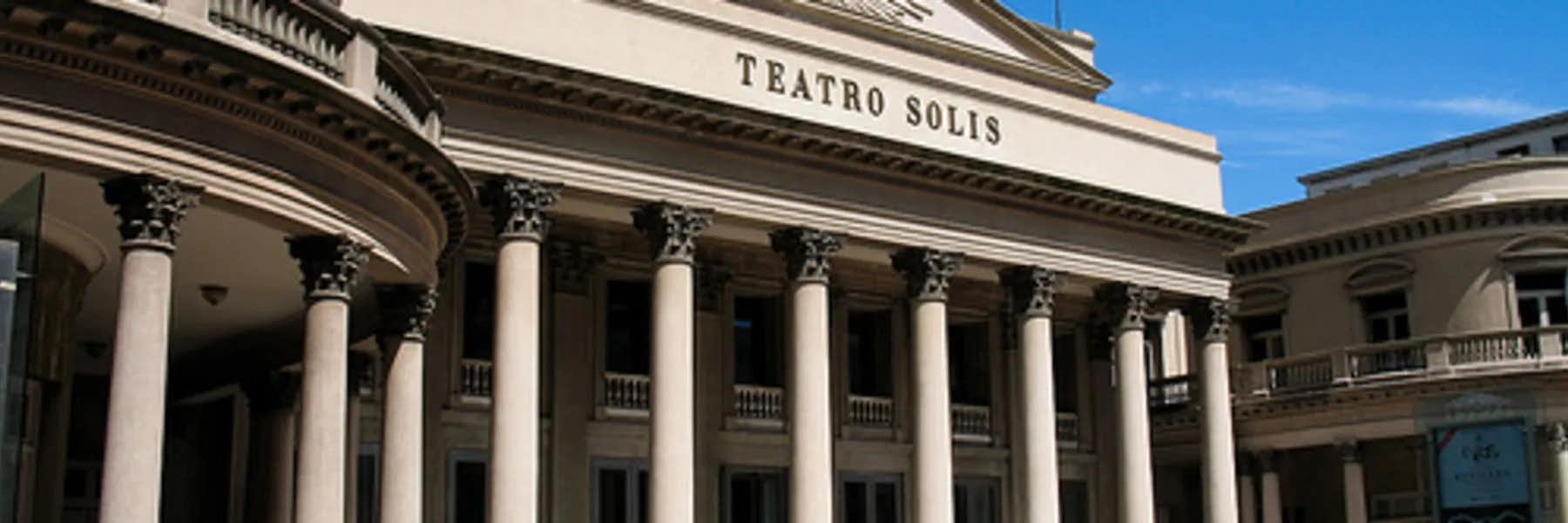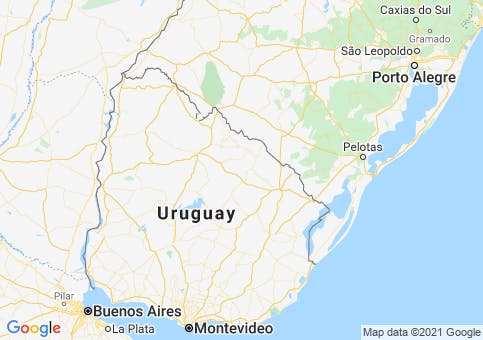Montevideo is Uruguay’s capital city as well as the country’s main commercial and cultural center. It sits on the Río de la Plata (called the River of Silver in English). The population of Montevideo’s Metro Area is close to 2 million—more than half of Uruguay’s population.
The city is known for its many large parks, tree-lined streets, sandy beaches, and wide avenues. Along the Montevideo waterfront is the rambla, the road and wide sidewalk that run along the city’s coastline. As you explore, you’ll notice pedestrian streets, as well as unique neighborhood shops, and restaurants.
The people in Montevideo take their leisure fishing from the rambla, chatting with friends in plazas and cafés, and browsing in outdoor markets.
Retire in Montevideo, Uruguay

The Uruguayan people are generally calm, laidback and tend to show patience, which adds to the relaxed feeling of the country and will help you settle in retirement.
At night there is dining, tango classes, theater, and various nightclubs. This includes nightly outdoor entertainment at Parque Rodo’s summer amphitheater during the 40 days of Uruguay’s Carnival.
While Montevideo’s coastline is not technically “oceanfront,” it looks like the ocean, with wide and sandy beaches. During the Southern Hemisphere summer (January and February) Montevideo’s beaches are thick with sunbathers.
The average summer high temperature is around 83 F. On the hottest summer days it can reach the mid-90s F. In the middle of winter, the average high temperature is 58 F. Suffice to say that while you won’t need a snow shovel, you will need to use heat in the winter and occasional air conditioning in the summer.
Lifestyle in Montevideo

You can enjoy a great lifestyle in Montevideo. With its pleasant outdoor areas, convenient shopping, and many entertainment options, Montevideo is an easy place to settle in.
Uruguayan foods are also a specialty in Montevideo. Gnocchi is a popular food in Italy and is also a favorite in Uruguay (where it’s called ñoqui). Parrillada is one thing that any true meat-eater must try when visiting Montevideo. Many parrillas (from “grill”, in Spanish) are quite large—often up to six feet long.
Uruguay offers an old colonial city, a sparkling beach resort, and a world-class capital. But it also has huge expanses of rolling ranch land, miles of uncrowded and undeveloped beaches, and a variety of small towns.
Uruguay’s music traditions include candombe, tango, and the local variation of murga; all of which developed in the Río de la Plata basin, and are now Montevideo favorites.
When people mention theater in Montevideo, the first place that comes to mind is the Teatro Solis (Solis Theater). It is a beautiful neoclassic building completed in 1856, located on the east side of Montevideo’s Ciudad Vieja. The Solis maintains a full and vibrant schedule of interesting events.
You’ll also find amazing performances at Montevideo’s modern Auditorio Nacional Adela Reta (Adela Reta National Auditorium). Completed in 2009, the Adela Reta has the largest stage in Montevideo with seating for 2,000 people. Operas, symphonies, ballets, and other significant productions are held here.
Montevideo is also full of culture and history. Montevideo’s Old City, Ciudad Vieja, is an eight-by-12 block area, which was once the entire original city of Montevideo, founded in 1730. Here, you’ll find the Metropolitan Cathedral, dating from 1790, gracing the plaza, and rows of tall trees shade wooden benches around a white gargoyle- and cherub-decorated marble fountain.
Real Estate in Montevideo

As mentioned, Ciudad Vieja is the oldest community in the city of Montevideo. The biggest question about any property in Ciudad Vieja is whether it is located in a building that has been restored.
The safest investment in Ciudad Vieja is to buy an apartment in a restored building on one of the three main plazas: Plaza Independencia, Plaza Matriz, or Plaza Zabala. Or to buy on the Sarandí pedestrian street between Plaza Independencia and Alzaibar Street.
As an example, there is a one bedroom one bath apartment in a beautifully restored building. It’s located near Plaza Matriz. While the building maintains its original look, the recently remodeled apartment is all modern with wood and tile flooring. The price is $150,000.
Adjoining Ciudad Vieja is Centro. Here you’ll find apartments for sale in both period and modern buildings. The most popular locations in Centro are on Avenue 18 de Julio (Montevideo's main avenue) near one of the plazas.
There is a three-bedroom one-bathroom apartment on the fifth floor of a building constructed in 1927. It’s near Plaza Fabini (also known as Plaza del Entrevero). The apartment is in good condition and maintains its original charm with wood flooring, paneled walls, and French windows. Price: 190,000.
The Pocitos neighborhood is two-and-a-half miles east of Centro. It was originally an independent town from Montevideo that finally merged into the growing metropolis. During various building booms, growth in Pocitos continues by removing single-family homes and replacing them with residential towers. Today, Pocitos is the most densely populated community in the city.
In Pocitos there is an eighth-floor one-bedroom one-bath apartment in a new building just two-and-a-half blocks from Pocitos Beach. Inside, you’ll find laminate flooring and a kitchenette with a granite counter top. Price: $172,500.
Cost Of Living In Montevideo, Uruguay
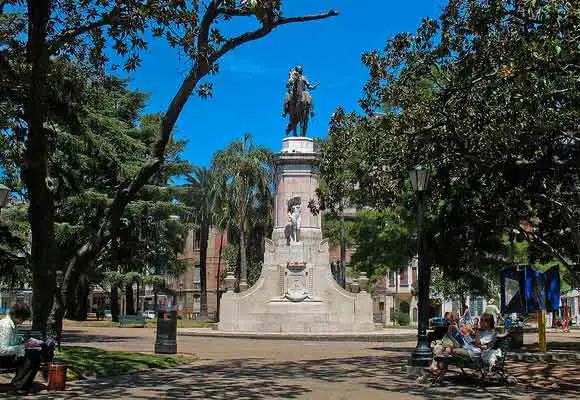
The cost of living in Montevideo isn’t the least expensive in Latin America. However, when you consider the quality of life, you may find it a good value for your money. For a couple owning an apartment, the cost of living in Montevideo can be a little over $2,300 per month.
Here is a sample of a monthly budget for a couple living in Montevideo:
| Item | U.S. $ |
| Rent (one bedroom apartment) | $900 |
| Homeowners Association Fee | $160 |
| Transportation (bus and taxis) | $138 |
| Electricity | $160 |
| Other Utilities | $36 |
| Cable TV | $27 |
| Internet | $31 |
| Two cell phone plans | $44 |
| Two healthcare plans | $150 |
| Health plan | $200 |
| Food and household supplies | $960 |
| Entertainment | $400 |
| Gifts and miscellaneous | $100 |
| Total: | $3,106 |
Living in Montevideo, Uruguay: Three Neighborhoods to Consider
By David Hammond
Living in Montevideo, Uruguay is becoming increasingly popular for expats looking for an urban environment with a year-round menu of dining, entertainment, cultural events, and social opportunities.
However, Montevideo is a big city covering 77 square miles with 62 different neighborhoods.
The three areas most popular with English-speaking expats include
Ciudad Vieja and Centro
The Pocitos Area
Carrasco.
This is not an all-inclusive list of good places to consider in Montevideo. There are other great neighborhoods, and special little spots to discover. However, these three areas are a good place to start.
(Before you read on, take a look at the video I shot of the neighborhoods in Montevideo I write about below.)
1. Living in Montevideo’s Ciudad Vieja (Old City) and Centro
The two oldest neighborhoods of Montevideo are Ciudad Vieja (Old City) and Centro. Ciudad Vieja was the original city of Montevideo when it was founded in 1730. Centro was the first addition to the Old City in 1861.
Ciudad Vieja and Centro are Montevideo’s main business and cultural centers. This is where you find historic architecture, the city’s original plazas, and public monuments. This is also the location of the most hotels, restaurants, theaters, art galleries, and museums.
Ciudad Vieja has the highest concentration of government, financial, and professional offices in the city. Approximately 100,000 people come to Ciudad Vieja to work on the weekdays, while only 16,000 people live in the area. For this reason, there is little happening in the evenings and on Sundays.
The exception is the east edge of Ciudad Vieja, near Plaza Independencia and the Solis Theater, where there are fine restaurants and popular bars open at night. In Centro there is a lot going on, at night as well as during the day.
The biggest attractions of Ciudad Vieja and Centro for English-speaking expats living in Montevideo is:
The opportunity to live in a renovated apartment in a historic building
Being close to the city’s best dining, theater, and other cultural events
The lowest average property prices of the three areas discussed in this article.
2. Living in Montevideo’s Pocitos Area
The Pocitos area is a secondary and more modern city center comprised of the three adjoining residential neighborhoods of Punta Carretas, Pocitos, and the west-edge of Buceo. Outside of Centro, the Pocitos area has the most restaurants, hotels, and nightlife. All three of these communities have unique characteristics, but for the purposes of this overview, we will lump them together.
The attractions of the Pocitos area are:
The largest selection of apartments to rent and buy in the city
Two large shopping malls
Lots of green space including two large parks and an 18-hole golf course
A long sandy beach is good for sunbathing, swimming, and beach volleyball in the summer
The largest community of English-speaking expats and other foreigners living in Montevideo.
3. Living in the Montevideo Neighborhood of Carrasco
A third area popular with expats is Carrasco. Carrasco is located on the western outskirts of Montevideo. It is different from Centro and Pocitos in that it has a much lower housing density.
Most of the homes in Carrasco are large single-family homes and spacious low-rise apartment buildings with large yards. It is near the Carrasco International Airport (Uruguay’s main airport).
The attractions of Carrasco are:
The availability of large single-family homes on their own large lots in a suburban setting
A long and wide sandy beach
A large modern shopping mall and large box-type stores
A Polo Club, which includes a renowned rugby team, and a lawn tennis club.
Neighborhood Living in Montevideo
While a part of the greater Montevideo metropolis, Ciudad Vieja, Centro, and the Pocitos area, are comprised of connecting neighborhoods, each with their own markets, butcher shops, hardware stores, and cafés. Things you need on a regular basis are usually just a short walk from where you live. This lends itself to a type of old-world living where you do not need a car, and you get to know the people who own and operate the small businesses and cafés in your neighborhood.
Ferias: Shopping in Montevideo
Most Montevideo neighborhoods have ferias (fairs). Ferias are farmer’s markets, which are set up once or twice a week. This is where people living in Montevideo get the freshest whole foods at the best prices. Some ferias also have vendors selling a variety of goods as well as food. Some of the larger ferias have just about anything you can think of—from clothing to framed prints to hand-crafted cookware; it’s all there, usually at below store prices.
Transportation in the City
The majority of people living in Montevideo do not own a car. When they need to go beyond their own neighborhood, they take the bus or a taxi.
You’ll find regular and well-routed bus service between all the areas discussed in this article. People from Pocitos regularly come to Centro and Ciudad Vieja for business at government offices, professional appointments, discount shopping, and for a variety of theater, music, and cultural events. And people who live in Ciudad Vieja and Centro regularly come to the Pocitos area to go to the mall and the beach during the summer.
You’ll find buses that go all the way across the city connecting Carrasco with the Pocitos area, Centro, and Ciudad Vieja. With that said, Carrasco is much more of a car culture, with the majority of homeowners driving to the places they need to go.
Where to Find the Hospitals
Most hospitals are located in or near an area of Montevideo known as Tres Cruses. It centrally located, and you’ll find regular and convenient bus service from most all areas of Montevideo.
Spanish Schools
Montevideo is known for its good Spanish Language schools. For English-speakers new to living in Montevideo, Spanish lessons are recommended. The Spanish Language schools in Montevideo are in Ciudad Vieja and Centro area.
5 Reasons to Move to Montevideo, Uruguay
By David Hammond
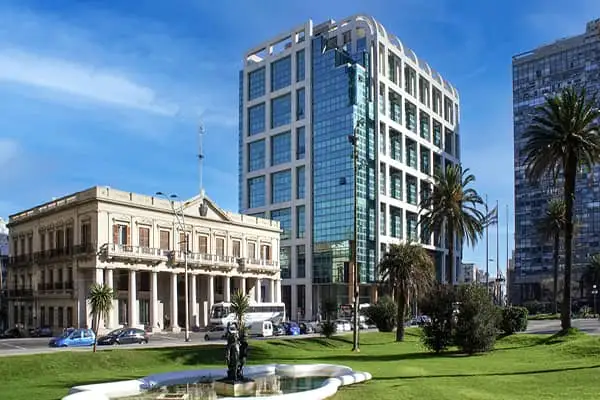
Are you considering expat life in a Latin American city?
If so, you’ve got a lot of great options.
My personal favorite is Montevideo, Uruguay.
Uruguay is a small food-producing country on the east coast of South America. Montevideo is Uruguay’s main economic and cultural center, and capital city. Half of Uruguay’s population of 3.5 million live in or near it.
I moved to Montevideo in 2014. And it’s proved to be a good match for my preferences and budget.
If you’re comparing Latin American cities as a place to move, consider the following five reasons to choose Montevideo.
1. Enjoyable Outdoor Common Areas
Parks and Plazas
If you live in an apartment, Montevideo’s many parks and plazas provide lovely and well-kept outdoor spaces to stroll, visit with friends, or read a book in the fresh air.
One of my favorite parks is Parque Rodo, with its lush landscape, interesting statues, and a small lake where you can rent a paddleboat. I also enjoy visiting Parque del Prado where you find a botanical garden and rose arbors.
Beaches
Montevideo sits on the Río de la Plata, which literally means River of Silver. While it’s called a river, it’s a sea-like estuary off the South Atlantic Ocean. Along this body of water, you find sand beaches where people go in the summer to sun, wade, and swim.
One of the most popular Montevideo beaches is Pocitos Beach. It's where regulars meet to play volleyball and bocce.
The Rambla (the Coastal Promenade)
Montevideo’s rambla runs the full length of the city’s waterfront (13 miles). It's the best place in the city to walk, run, roller skate, or ride a bike. On the rambla, you can go out and back as far as you like without the worry of crossing streets or entering traffic.
2. An Easygoing and Inclusive Culture
Easygoing
While many cities are described as fast-paced and impersonal, Montevideo is more commonly described as warm and easygoing (or muy tranquilo, as they say in Uruguay). It’s a culture where relationships are generally more important than schedules.
Inclusive
Uruguay is where you find the largest middle class per capita in Latin America. Everyone in Montevideo gets access to healthcare (without the worry of going into debt).
Every primary and secondary student in Uruguay’s public-school system receives a free laptop computer. And anyone who can meet the academic requirements can attend the state university in Montevideo for a tiny fee.
Montevideo’s main performance theaters schedule periodic free and low-cost events. So everyone, regardless of their budget, can enjoy the first-rate symphony.
Also, the city of Montevideo provides free WiFi spots in most plazas, parks, and beach areas.
3. Responsible City Services and Public Transportation
City Services
In Montevideo, you find:
Clean water
A modern sewer treatment system with collector terminals and storm drains
97% renewable energy usage
Nightly garbage pick ups
Bus Service
In Montevideo, the city bus service is well-routed and dependable. It’s why most expats, including myself, get by fine without owning a car. Besides the bus service, you find plenty of taxis and remises. (A remise is a private car-and-driver service that costs just a little more than a taxi.)
4. Interesting Dining and Entertainment Options
In Montevideo, it’s customary to eat four meals per day (Desayuno, Almuerzo, Merienda, and Cena). And each meal provides an opportunity to socialize.
The Morning Meal—Desayuno 8 a.m. to 9 a.m.
Desayuno includes coffee, tea, or juice with something to eat, such as croissants, yogurt, or fruit. It can also include croissant sandwiches with thin slices of ham and cheese. You find cafes (many with outdoor tables) that offer Desayuno menu sets at one low price.
The Midday Meal—Almuerzo 1 p.m. to 2 p.m.
Almuerzo is a heavier meal that often includes meat, fish, or pasta. Many cafes, restaurants, and to-go counters offer weekday menu specials to compete for the business of office workers. Some of the restaurant specials include a glass of wine and dessert.
The Afternoon Snack—Merienda 4 p.m. to 5 p.m.
Merienda is another light meal, often coffee, tea, and a snack. You find many coffeehouses in Montevideo, ideal for merienda. They serve a range of coffee drinks, baked goods, and small sandwiches. Some also serve salads and yogurt. (If you’re an early-to-bed, early-to-rise person, like myself, this an ideal time for a weekday meetup.)
Dinner—Cena 9 p.m. to 10 p.m.—Often Later in the Summer
Cena is the second heavy meal of the day with meat, fish, or pasta. You find a wide range of restaurants serving dinner in Montevideo. The most popular evening meal is barbecued beef, followed by Italian, Spanish, and French dishes.
You also find many other types of cuisine in Montevideo. This includes Armenian food, Korean food, and sushi. And for those who don’t eat meat, you find several vegetarian restaurants in Montevideo.
Interesting Nightspots
In Montevideo, you find wine bars, craft-beer bars, jazz bars, Irish bars, and tango clubs.
Live Performances
You find two impressive live performance theaters in Montevideo. One is the Solís Theater, which opened in 1856. The other is the modern Adela Reta National Auditorium with seating for 2,000. At both of these theaters, you can enjoy symphony, ballet, and choral productions.
5. Affordable Healthcare Plans
Montevideo is not a medical tourism destination with low-cost à-la-carte medical services. The good value here is a healthcare membership plan with a private hospital-based healthcare organization called a mutualista.
Mutualista
A mutalista provides medical services directly to its enrolled members. The cost includes a monthly membership fee (currently around $50) plus, a small copayment when you see a doctor or use the hospital’s services.
With a mutualista, there is no insurance company between you and the hospital organization that provides your medical care.
Covered services include doctor visits, most tests and procedures, surgeries, emergency-room care, and hospitalization.
Asociación Española
While you find many mutualistas in Montevideo, the most popular with expats is Asociación Española. Española’s main headquarters fills more than a dozen buildings. And its many clinics spread throughout Montevideo.
Asociación Española’s departments include a cardiology center and a Genomic Diagnosis center to detect and prevent heredity-based illnesses and syndromes.
Note: Española is a private company that sets its own acceptance guidelines for age and pre-existing conditions. The level of scrutiny increases for new applicants over age 65. If you don’t get accepted to Española because of age or a pre-existing condition, you may not be out of luck. A residency specialist, familiar with many plans, can often suggest the best alternative.
Private 24-Hour Emergency-Response/Ambulance Service
You also find several private plans that provide 24-hour ambulance-with-a-doctor emergency response service. If you have a medical emergency, a private ambulance with a doctor comes to you. At the current exchange rate, coverage for this service runs between $18 and $30 per month.
10 Things to do in Montevideo, Uruguay
By David Hammond
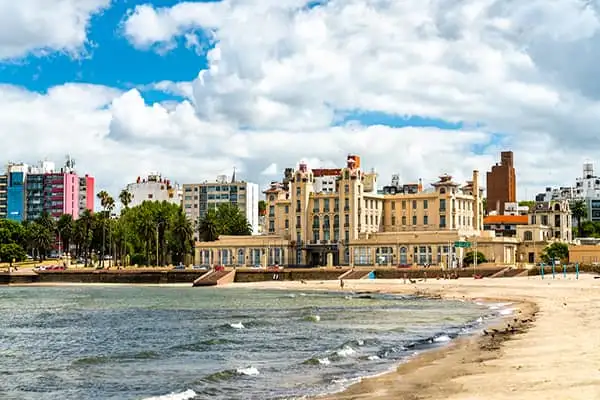
I’ve been living in Montevideo for six years. And I can tell you first hand, it’s a unique place—rich with interesting sights, tasty food, and unique cultural traditions.
If you like exploring new cities, Montevideo, Uruguay’s capital, is definitely worth it.
What’s the best way to plan your time in Montevideo?
On your first day, I recommend an organized tour. That way, a professional guide takes care of everything, while you shake off a long flight and get acclimated to your new surroundings.
After that, if you’re adventurous and speak a few words of Spanish, you may want to spend a couple of days exploring on your own.
If that’s you, let me recommend 10 things to see and do for a memorable time in Montevideo.
1. Take a Walk on the Rambla
Montevideo is famous for its 13-mile-long coastal promenade called the rambla.
The rambla provides a scenic place to walk, run, roller skate, or ride a bicycle. On the rambla, you can go out and back as far as you like with no traffic or intersections to cross.
It’s a popular place to spend time on weekend mornings and summer evenings.
2. Eat Barbecued Beef at a Parrilla
Uruguay is a cattle-raising country. And Uruguay's national dish is beef grilled over wood coals. Uruguayan restaurants that serve barbecued beef (and chicken) are called parrillas (grills).
You find several landmark parrillas inside the Mercado del Puerto. It's a huge building across the street from the Port of Montevideo, in Montevideo’s Ciudad Vieja (Old City).
While the parrillas in the Mercado del Puerto are the most visited by travelers, you find good parrillas throughout Montevideo. (Often with lower prices.)
One of my favorites is La Otra in Montevideo’s Poctios neighborhood.
3. Visit the Mausoleum of Artigas (Uruguay’s National Hero)
Plaza Independencia is a large stately plaza where many national ceremonies take place. In the center of the plaza is a 55-foot-tall statue of General José Artigas on horseback.
Artigas led the fight for the region’s independence. He’s Uruguay’s most prominent national hero.
A set of stairs on both sides of the statue lead down to a large below-ground room with Artigas’s ashes. On each side of the urn is an armed honor-guard solder. On the concrete walls is a timeline of Artigas’s life.
4. Sample Tannat and Other Local Wines
Uruguay produces world-class wines. Its signature grape, tannat, makes a full-bodied red wine that pairs well with steak.
Much of Uruguay’s wine is produced in small family-owned wineries on the rural edges of Montevideo and the neighboring region of Canelones.
Just 11 miles from Montevideo’s Centro is Bodega Bouza, it’s ranked as the 26th best winery in the world by the World’s Best Vineyards, a prestigious academy of wine and travel experts.
Bouza offers tours, wine tasting, and elegant midday meals. (Many of Bouza’s fresh ingredients come from its on-site kitchen garden.)
Besides excellent tannats, Bouza offers several other wines. These include an award-winning albariño, merlot, tempranillo, chardonnay, riesling, and a pinot noir.
Note: the blood alcohol level to drink and drive in Uruguay is zero. So, you need to hire transportation. You can get to Bouza by city taxi or remise service in less than 30 minutes.
(Remise service is a private car-and-driver for hire. Most Montevideo hotels can help make the arrangements.)
If you don’t have time for a winery visit, you can sample the area’s best wines at the Montevideo Wine Experience. It’s the city’s best wine bar located in Ciudad Vieja.
5. Browse at a Local Street Market
One of Montevideo’s long-held traditions is its street markets, called ferias. Ferias set up one or two days per week in almost every Montevideo neighborhood. They include rows of produce stands and trucks selling cheeses, fish, and chicken.
Shopping at a feria is a classic Montevideo experience.
A few Montevideo ferias are huge. Besides food, vendors sell a wide range of goods. Everything from potted plants and goldfish to clothes, kitchenware, and handmade craft items.
One of the largest ferias is Feria de Villa Biarritz. It sets up on Saturday mornings in Villa Biarritz Park in Montevideo’s Punta Carretas neighborhood.
Another large feria is Feria de Tristán Narvaja. It sets up on Sunday mornings on Tristán Narvaja Street, starting at 18 de Julio, a main avenue. It's in Montevideo’s Cordón neighborhood.
If a street feria doesn’t fit your schedule, visit the Mercado Agricola. It’s a large indoor market with a feria-like atmosphere, which also includes cafes and a food court. (It's just four blocks from Uruguay's impressive Legislative Palace.)
6. Try a Chivito
A chivito (which literally means goat) is a type of roast beef sandwich in a bun invented in Uruguay. Besides a slice of roast beef, a chivito often includes Canadian bacon, lettuce, tomatoes, onions, peppers or olives, an egg, mozzarella cheese, and mayonnaise. A chivito is usually accompanied by french fries.
If eating a big sandwich isn’t for you, you may prefer to order a chivito al plato. It includes everything that’s inside a chivito on a plate. With no bun, the ingredients are stacked on a bed of French fries and Russian potato salad.
Most cafes, chain restaurants, and bars in Montevideo serve a chivito. You find one of the best chivitos in Montevideo at Bar Arocena in the Carrasco neighborhood.
A place that specializes in chivitos is Chivitería Marcos in Montevideo’s Pocitos neighborhood, just a couple of blocks from the Montevideo Shopping mall.
7. Visit the Torres García Museum
In the realm of art, nothing says Uruguay more than the works of Uruguayan artist Joaquín Torres García (1874 to 1949).
García is an internationally acclaimed artist who developed a set of artistic principles called Universal Constructivism, which can be applied in the creation of paintings, sculptures, and murals. (It’s a genre that includes grid patterns containing symbolic images. A little reminiscent of Egyptian pictographs.)
García’s contribution to the art continues to echo through time. Many Uruguayan artists (known as members of the Southern School) still adhere to García’s artistic principles. And as recently as 2016, his work was exhibited in New York’s Museum of Modern Art.
The Torres García museum is in Ciudad Vieja. It's a low-key place where you can see original works that show the stages of development of this great artist.
If you want to buy a Montevideo souvenir, the Torres García museum gift shop is the place to go.
It’s where you find prints, mugs, and other gifts with images of Torres García’s most popular works. They are unique to Montevideo. And the prices are more reasonable than you’d expect in a museum gift shop.
8. Enjoy a Coffee at a Cool Montevideo Café
Do you enjoy drinking good coffee in a unique café atmosphere? If so, you’ll find many interesting coffeehouses and cafes to choose from in Montevideo.
Following are three of my favorites:
Café Gourmand is a cafe that roasts its own coffee and also serves great French cuisine. (The owner is French.) It’s located in Montevideo’s Cordón neighborhood, just east of Centro.
Sometimes Sunday Café is a small place with a stylish interior, great coffee, and creative dishes. It’s operated by a Colombian couple (who really know coffee) in Montevideo’s Ciudad Vieja, not far from the Mercado del Puerto.
La Latina Café is a place you can spend some time on your computer or do a little reading over a coffee and a tasty baked good. The interior is inviting with a home-like decor, a library wall, and a patio. It’s on Avenue Brasil in Montevideo’s Pocitos neighborhood.
9. Take a Stroll Through Parque Rodó
Rodó Park is a large and lovely park in Montevideo’s Parque Rodó neighborhood. It’s named after José Enrique Rodó (1871 to 1917), a renowned Uruguayan essayist.
Besides large areas of lawn, trees, and a playground, you find
an amusement park
a large summer amphitheater
a small lake with pedal boats you can rent
the National Museum of Visual Arts
an outdoor photo gallery
and an evening craft fair
Just beyond Rodó Park, you find Playa Ramírez, a sand beach with a nearby waterfront roller skating rink.
10. Drink a Shot of Uvita at Baar Fun Fun
Baar Fun Fun is a small intimate tango bar with regular live performances. It’s been in business since 1895. Besides tango, the bar is famous for a wine liquor called Uvita (made from a secret patented recipe), which is still served.
A few years ago, a new building was constructed on the site. However, Baar Fun Fun, a historic landmark, was placed back in its original spot in the new building. While the exterior is new, the interior feels the same. It includes old photos and posters from the bar's long tango-rich history.
